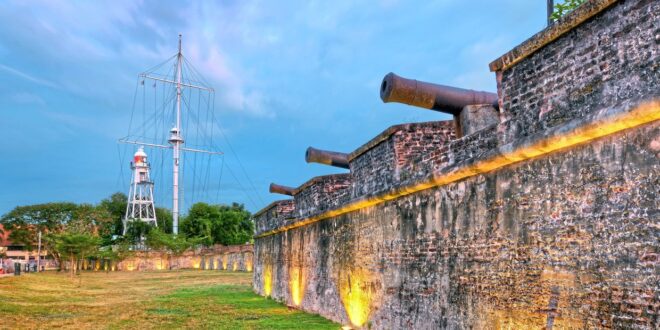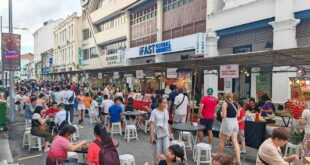Fort Cornwallis had never been involved in battle, but was a cornerstone of Penang’s growth over the centuries.
First established not long after Captain Francis Light claimed the island for the British Crown, it served more as an administrative base.Yet the potential firepower offered by its guns allowed the port in George Town to flourish as an important trading hub, while its sturdy walls outlasted two world wars and everything else in between.
Many of these narratives have faded from public consciousness over time, but that is about to change thanks to ongoing archaeological and conservation works.
A key component is the Fort Cornwallis Storage Rooms Museology project, which will see 10 disused bunkers along the fort’s southern wall converted into museum and exhibition spaces.
Slated to open by the end of 2024, it will chronologically tell the story of the fort and its role in the context of both George Town and Penang’s history.
Taking pride of place will be artefacts, including those unearthed during recent archaeological works. These will provide tangible links to the past and bring to life the stories of the people who built, worked at or had been at the fort.
The facade of the fort which is being restored. — Photos: CHAN BOON KAI and JEREMY TAN/The Star
There will be images, graphics, models and audio visuals showing how the structure had changed over time, while shining a spotlight on contemporary efforts to return it to its former glory.
The public got a taste of what’s to come in the “A Day at the Fort” event organised by Think City in late May.
There were mini exhibitions on Archaeological Treasures and Traditional Building Materials.
Researcher Nurul Ain Mohd Ali from Universiti Sains Malaysia’s Centre for Global Archaeological Research, was among those who briefed the public on the items found.
She is part of an excavating team at the fort since 2018, primarily to restore the south and west moats which were filled in the 1920s to curb a malaria outbreak.
They found over 30,000 artefacts, ranging from ink, pharmaceutical and drink bottles, to clay smoking pipes, ceramics, old coins, personal items and even carbonised fruits and biscuits.
“Every object has an interesting story to tell. These are essentially time capsules that showed what life was like at a certain period in time,” she said.
Tourists walking by Fort Cornwallis’ row of old bunkers, which have been earmarked to be turned into a museum and exhibition spaces.
Other notable artefacts were cannonballs, which weight surprised many visitors who attempted to pick them up. There were also coins from circa 1780, as they bore images of King George III who reigned from 1760 to 1820.
These were likely brought over by early settlers, perhaps the crew of Light’s ships or the subsequent British East India Company (BEIC) boats. The coins might have been accidentally dropped and then were forgotten for centuries.
“There were also smoking pipes with unique hand-carved motifs. These were likely used by those who built or worked at the fort and thrown away when broken.
“We also found drink bottles with the logo of Fraser and Neave which we popularly know today as F&N, as well as charred Huntley and Palmers biscuits, a brand that is still around. We believe these charred items were a result of wastes being burned,” Nurul continued.
She said the biggest thrill was when they unearthed a pair of cannons near the fort’s outer defensive structures.
Both bore the insignia “GR” which stood for Georgious Rex, a Latin reference to King George III, which would date the cannons to the late 18th century.
“When we first unearthed the cannons’ handles, we knew it would be a significant finding. To physically rediscover and touch something lost to time, is so different than just reading about it,” Nurul added.
Besides the mini exhibitions, visitors to the event were also invited to share their personal stories regarding the fort, or donate relevant artefacts and old photographs.
Works progressing on the west moat.
Pending authentication and curation, some may end up as exhibits in the museum, preserved for posterity.
Think City managing director Hamdan Abdul Majeed said, “The overall Fort Cornwallis project exemplifies our ground-up approach to urban revitalisation.
“It is not just about preservation, but creating a living history shaped by the community. Through grassroots activation like ‘A Day at the Fort’, we empower residents to actively participate in this transformative journey.
“This will ensure the history of Fort Cornwallis is authentically told through the voices of those who hold it dear, making the narrative true and heartfelt.”
Videographer Andrew Han, who recorded some of the visitor testimonies, said many recollected experiences at the fort decades ago.
“Some of the most interesting anecdotes included people coming to touch the Seri Rambai cannon, a ritual which was believed to aid fertility,” he said of the fort’s most famous artillery piece, which was believed to have been cast in the early 1600s.
Educational fun
The “A Day at the Fort” event also featured several hands-on activities for children, including a Young Archaeologist Programme.
Nurul with the cannonballs found at the fort.
Here, they learned what it was like to peel back the layers of history. There was a tray of sand which they could sift through and discover bones, pottery fragments, coins and other things.
Meanwhile, the Build with Bricks station allowed visitors to recreate mini sections of the fort’s walls with tiny bricks and glue.
Think City senior museology manager Cheong Ni-Tsia said these were meant to get younger generations interested in history and archaeology, because they would be the ones carrying on the duty to protect and preserve the landmark in decades to come.
“Today was a teaser to let the public know that a museum is coming and to get them excited about other initiatives that we have planned.
“Fort Cornwallis played an important role in Penang’s history and we want to keep people abreast of the works that are currently being done to restore it,” said Cheong.
Among those who enjoyed the activities were office admin employee Liyana Adhwa Khalid, 34, and her two children Aisyah Humaira and Haura Amani Muhammad Hafiz, aged 11 and six.
Liyana said the little ones enjoyed hands-on art activities and the event had the added benefit of teaching them about local history.
Siblings Aisyah Humaira (right) and Haura Amani learning how to dust off buried bones at the Young Archaeologist corner.
“People often say that history is boring, but when you make it engaging and fun like this, children will be drawn to it,” she opined.
Taiwanese national Bob Chuang, 46, who is married to a local, was also spotted checking out the artefact scanning station with his son Kai Xun, seven.
“My wife said she hadn’t been inside the fort for nearly 30 years and was intrigued by the new developments.
“It is always good to let younger generations learn about a place’s history so they can better appreciate and understand how local society and culture became what it is today,” Chuang remarked.
There was also a Creative Jam where young visitors got to put their own touches to paper mache sculptures of the fort. Their handiwork might also be placed among future exhibits.
Art teacher Tania Ng, 33, who oversaw the activity, said this reflected how buildings were often changed or added to, by subsequent generations of users.
“By making their work part of the fort, we hope it will spark their interest to preserve our heritage,” she said.
Some of the old ceramics, ink bottles, drink bottles and pharmaceutical bottles that were unearthed during recent excavations around the fort.
Grand plans
Fort Cornwallis is one of the oldest structures in Malaysia and a Category I listed building of federal relevance under the care of the National Heritage Department (JWN).
It was built on the northeastern tip of Penang island, close to where Light was said to have first come ashore after taking possession of the island.
Initially just a crude stockade built with wooden posts and stakes, it was named after Charles Cornwallis, the second Earl Cornwallis who was governor-general of Bengal in India at the time.
As the wooden structure fell into disrepair, and the rising threat of the French following the outbreak of the Napoleonic Wars, the decision was made by Colonel RT Farquhar – then Lieutenant-governor of Prince of Wales Island (which Penang was formerly known as) – to rebuild the fort with brick and stone in 1804.
This was completed at a cost of $80,000 Straits Dollars in 1810 under Norman Macalister’s term as governor. It was a squarish design, with diamond-shaped bastions at each corner.
Though intended as a military structure, its function was more administrative for the BEIC.
The Supreme Court of Penang was established here in 1808, starting the country’s modern legal system.
A 22m-tall lighthouse was erected in 1882 and remains the second oldest lighthouse in Malaysia. A flagstaff, almost twice as tall, was added sometime later and used as a means of communication with another outpost on Penang Hill.
Chief Minister Chow Kon Yeow (centre) looking at the two historical cannons that were unearthed during excavations of Fort Cornwallis. — Filepic
A moat roughly 9m-wide and 2m-deep once surrounded Fort Cornwallis. The south and west moats were re-excavated as part of conservation works and are now in the final stages of completion.
Cheong said only landscaping works remained for the south moat and its reopening would be announced soon. The west moat is expected to follow in 2025.
The disused bunkers that are to become the museum, were previously used to store arms, gunpowder and projectiles.
Some were also accommodation for personnel and to hold prisoners.
As the fort evolved over time, there are successive layers of history embedded at the site.
The conservation plans and museum will present and chronicle this under three distinct periods – the formative years under British colonial rule, pre- and post-World War II, and post-independence.
The Fort Cornwallis project is guided by three key documents – the George Town World Heritage Site Special Area Plan (SAP), the George Town Strategic Master Plan (Public Realm Addendum) and the Fort Cornwallis Conservation Management Plan (CMP).
Its implementation agency is the George Town Conservation and Development Corporation (GTCDC) – a partnership between the Penang Government’s Chief Minister’s Incorporated (CMI) and Think City, with technical advice from the Aga Khan Trust for Culture.
The restoration process involved desk research, site and building assessments, physical investigations, archaeological works, testing and experimentation, pilot demonstrations, mock-ups and full project implementation – all of which were done under advice and consultation from historians, archaeologists, conservation architects, structural engineers and master builders specialising in traditional construction.
The rejuvenation of the fort is part of Penang’s wider North Seafront Improvement Programme that covers 14 projects using a culture-based approach to sustainable socio-economic development.
There will be more open calls for memories and artefacts for the fort’s museology project in the coming months.
Those who wish to contribute can email to fortcornwallis@thinkcity.com.my
 BeritaKini.biz Berita Viral Terkini di Malaysia
BeritaKini.biz Berita Viral Terkini di Malaysia





